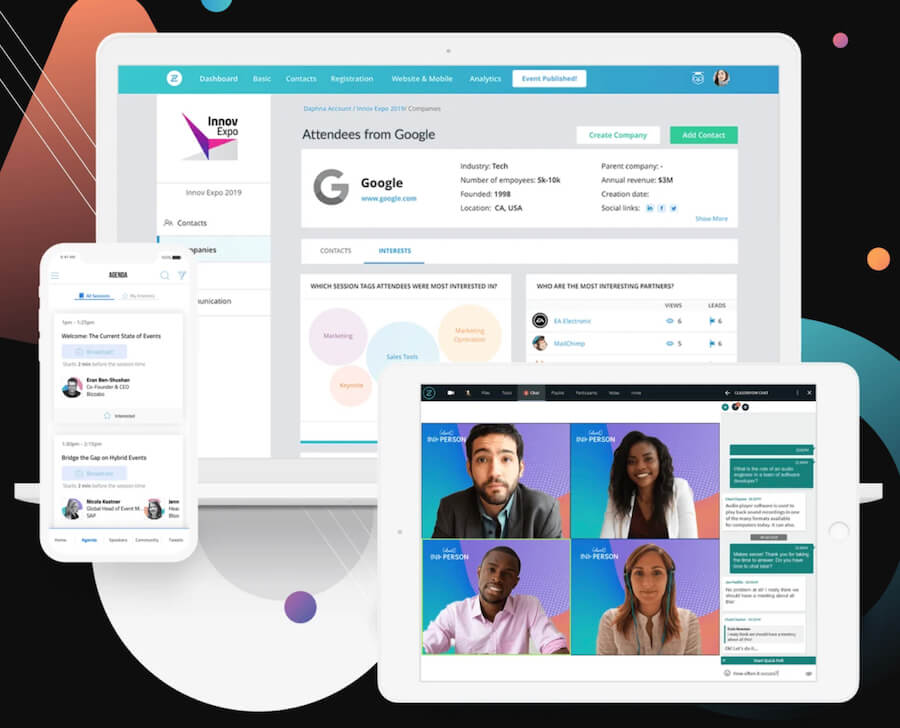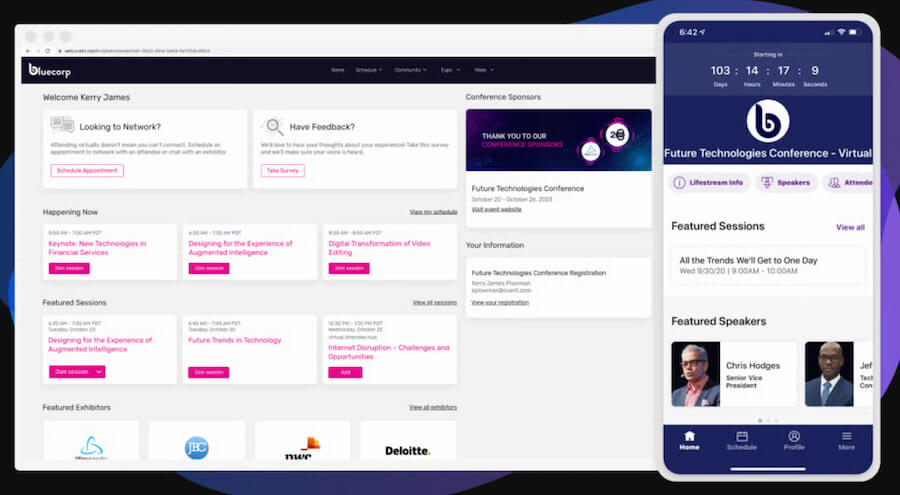For 77.7% of business professionals, in-person conferences provide the best networking opportunities. Learn more about this topic by reading these business networking statistics.
29 Business Networking Statistics for New Opportunities (2024)
This article is part of a larger series on Sales Management.
Business networking helps you develop professional relationships that can generate referral sources, sales leads, partnerships, and career opportunities. Nowadays, networking is being shaped by several key trends, including the rise of virtual and hybrid events over purely traditional ones. This article offers 29 business networking statistics to help you explore how networking impacts your business and career.
General Business Networking Statistics
These business networking statistics give an overall picture of what networking can do for you, in-person or online. Some of these data points also show the opportunities created through networking and how people evaluate others they meet at various events.
1. 70% of businesses acquired new leads using trade shows as a business networking strategy.
(Source: DisplayWizard)
Takeaway: Despite the rise of online businesses and events, many companies are reaping the benefits from physical trade shows by acquiring new leads. For them, it is the best way to showcase their products and to connect with prospects on a personal level.
Pro tip: Networking events are great for generating leads. However, using a customer relationship management (CRM) system with lead scoring tools like HubSpot CRM is more effective. Its lead scoring tool sifts through and prioritizes the leads most likely to convert into customers, saving time and boosting revenue.
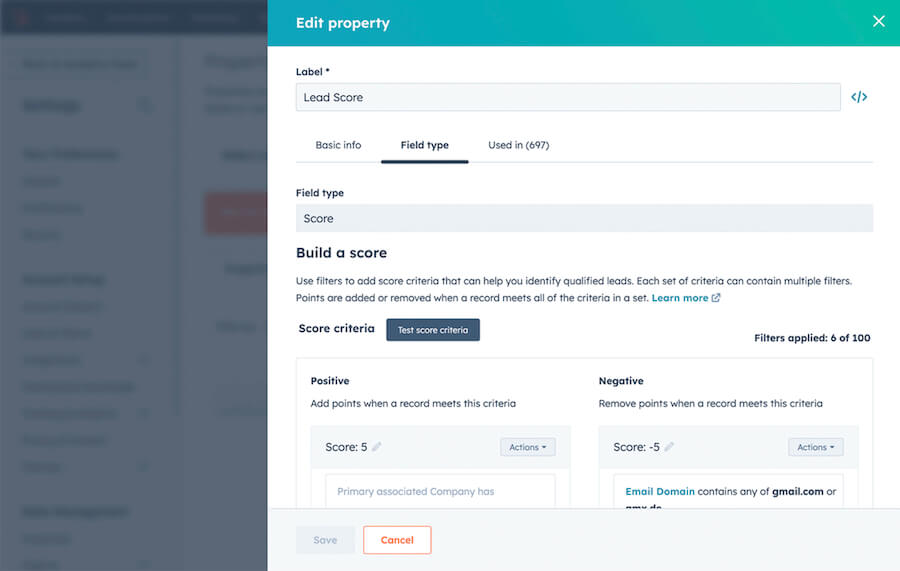
HubSpot CRM lead scoring tool (Source: HubSpot)
2. 64% of trade show attendees are not current customers of the exhibited businesses.
(Source: DisplayWizard)
Takeaway: Trade shows and expos are traditional events that allow you to meet hundreds of decision-makers easily and begin developing meaningful relationships with them. This networking stat, in particular, shows how many opportunities a single trade show offers, as most attendees do not have to pay for relationships with any exhibitors. For businesses, these events provide an opportunity to expand your customer base.
3. 39% of business card recipients could walk away from a business due to its business card design.
(Source: Newstrail.com)
Takeaway: Most potential leads, partners, and decision-makers who receive a business card use it as a reference point for evaluating a business. With that in mind, business cards should accurately reflect the personality of your brand—hence, you should be particular in your business card design. Avoid card design fails that drive receivers away, such as pixelated graphics, unreadable text, and startling color combinations.
Pro tip: Getting dozens of business cards at an event means tons of entries to add to your database. You can expedite the data entry process using a CRM with business card scanning capabilities. Popular CRMs like Bitrix24, for instance, allow you to scan a card and have the data automatically added to the system as a lead or contact record through its mobile CRM.
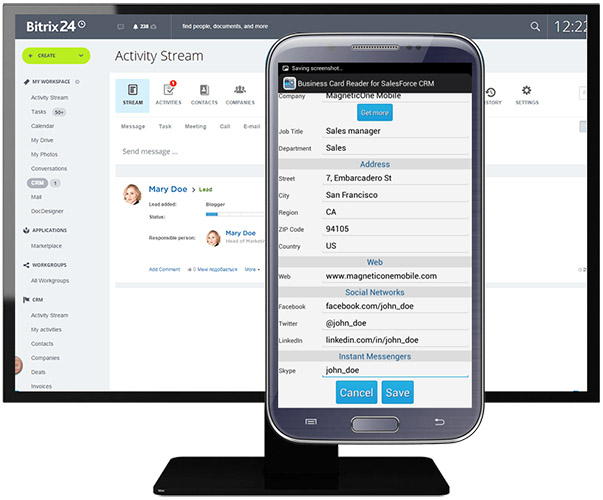
Bitrix24 business card scanner feature (Source: Magnetic One Mobile)
In-person Business Networking Statistics
In-person interactions have a positive impact on business and professional industries, including on their productivity and workplace environment. There are aspects that simply cannot be replicated by a virtual interaction. Find out the advantages and trends of in-person networking for both attendees and event organizers by reading the statistics below.
4. 65% of businesses consider in-person networking via trade shows invaluable for their marketing efforts.
(Source: DisplayWizard)
Takeaway: Despite the popularity of online conferences, many still prefer face-to-face interactions. This stat highlights the enduring value of face-to-face interactions and their impact on building relationships, establishing trust, and driving business growth. While virtual events have become increasingly popular due to the pandemic, they can only partially replace the benefits of in-person interactions.
Pro tip: Networking events can be a great pillar of your business marketing strategy. You can meet potential customers, peers, and professionals, exchange business cards, and showcase your products or services. With the right approach, these events can lead to valuable partnerships, referrals, and new business opportunities.
5. 76.6% of business event organizers say in-person conferences are critical to their company’s success.
(Source: Bizzabo)
Takeaway: While much of networking is for developing referral sources or career advancement, attending professional events can also be an effective lead generation method with high conversion rates. In-person events specifically provide one-on-one, personal conversations to help develop trust in your brand—yielding a better chance of obtaining new customers.
6. For 69.7% of businesspeople, B2B conferences provide the best opportunity to learn about new products & services.
(Source: Bizzabo)
Takeaway: Business-to–business (B2B) companies rely on other companies’ patronage for increased sales, and B2B conferences are a great avenue for promoting their new products and services. Networking events can help businesses identify new leads during personal interactions, learn industry standards from panel discussions, and identify key trends as they change over time.
Pro tip: A CRM system like Zoho CRM effectively records lead sources. By using the “lead source” field in Zoho CRM, you can track the channels your leads are coming from. Whether through networking events, social media, email campaigns, or referrals, you can categorize and organize your leads based on their sources.
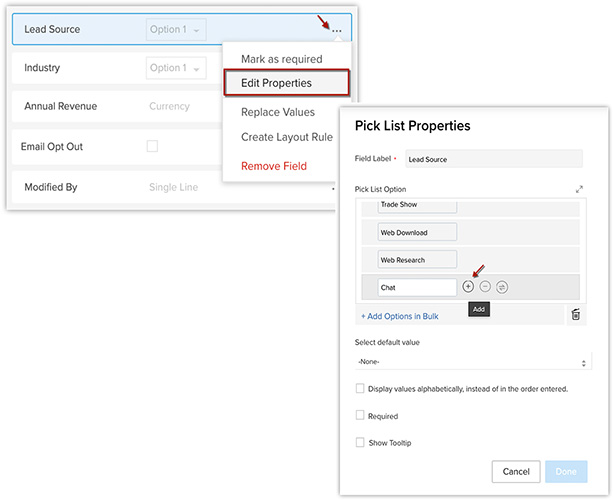
Zoho CRM allows users to identify the source of leads. (Source: Zoho CRM)
7. 77.7% of business professionals agree that in-person B2B conferences are the best way to find networking opportunities.
(Source: Bizzabo)
Takeaway: A diverse mix of business professionals, decision-makers, and industry leaders often attend B2B conferences. These events, especially those conducted in person, help attendees forge valuable relationships with other businesspeople in their respective industries. Businesses can derive referrals and new leads from these new connections.
8. More than half (62.9%) of B2B conference attendees expect in-person events to use smart badges or mobile event apps.
(Source: Bizzabo)
Takeaway: The majority of business conference attendees say modern technology is vital for events because they make networking easier. Smart badges, for instance, store your contact information and answers to a pre-event questionnaire. Your badge lights up and sends a notification to your smartphone when it comes close to another participant with common interests.
Pro tip: Read our guide to the best virtual conference platforms to see the top solutions you can use to replicate in-person events. These tools offer built-in engagement features, such as polls, live chat, Q&A (question and answer), screen sharing, and digital whiteboard.
9. At least half of B2B conferences are now held in person, according to 87.1% of organizers.
(Source: Bizzabo)
Takeaway: An overwhelming majority of organizers reported an almost 5% increase in growth registration compared to their past B2B conferences. This means that in-person events are now regaining traction. Businesses ought to take advantage of this trend by sending representatives to attend in-person conferences as these events provide them with opportunities to meet new leads.
10. More than a third (38.8%) of organizers hold satellite events in various locations simultaneously with a big B2B conference.
(Source: Bizzabo)
Takeaway: Holding micro-events or satellite events is a thoughtful way of expanding the reach of a B2B conference, especially among those unable to attend in person. This allows remote sales teams to be part of the conference even if they are working in the field. It also promotes accessibility and inclusion within the company.
11. 14.2% of B2B conference attendees still consider networking a top priority when attending an event in person.
(Source: Bizzabo)
Takeaway: B2B networking helps a company build positive brand visibility and recognition among potential partners and customers. Speaking with other attendees helps them become familiar with your business, and these connections could spark referrals to people who could benefit from your product or service.
Pro tip: Follow our guide on how to get referrals and generate quality leads for your business. Aside from networking, we’ve outlined other steps to increase your referrals and cut the time you spend on cold outreaches.
12. For 72.5% of conference organizers, the success of their recent gatherings is attributed to their event management platform.
(Source: Bizzabo)
Takeaway: One of the best decisions that businesses can make is to invest in a good event management platform like Bizzabo or Cvent. Tools like these consolidate tasks such as budgeting, scheduling, attendee registration, and communication in one platform. They also make it very easy for attendees to register and track updates related to the conference.
Virtual Network Statistics
Online networking has transformed the way people connect and interact with each other. Through social media and professional networking sites, individuals and businesses can expand their reach, build relationships, and enjoy a borderless audience reach. These facts about networking online show the benefits of adding online networking to your face-to-face networking efforts.
13. To date, LinkedIn has a global reach of over 1 billion, with the United States as its leading market with more than 211 million users.
(Source: LinkedIn)
Takeaway: LinkedIn is an excellent social networking site for professionals looking to make useful connections or start a new career. Users can search for job vacancies, hire new workers, research companies, and obtain information on industry trends. Having a strong presence on this site by updating your profile and engaging with other members could lead to new job or business opportunities.
Pro tip: Head over to our LinkedIn review to learn more about this platform’s tools for promoting job hiring and recruiting new employees. We also included its pros and cons, specific use cases, pricing details, top features, and a summary of user reviews.
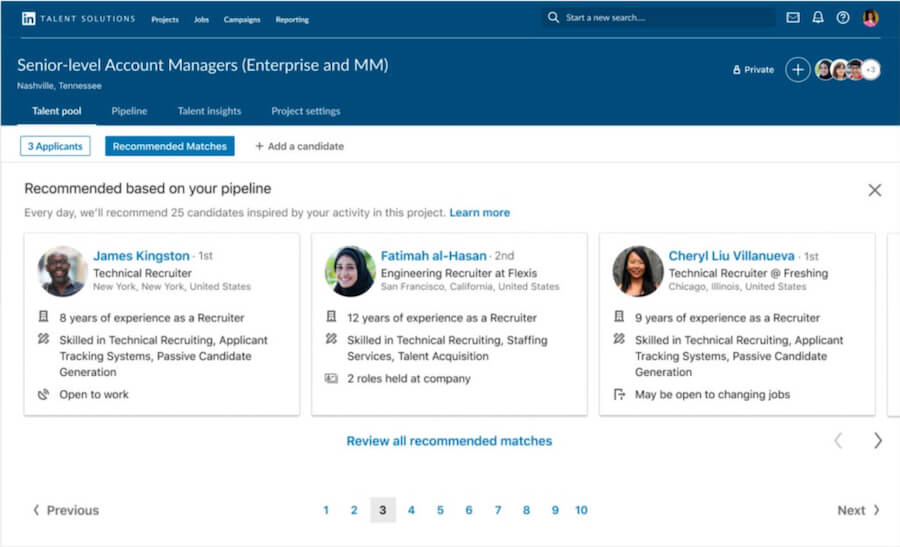
LinkedIn’s Recommended Matches for job candidates (Source: LinkedIn)
14. Facebook is still the biggest social media platform, with over 3 billion monthly active users.
(Source: DemandSage)
Takeaway: Whether you’re a solopreneur, freelancer, or a business entity, Facebook is a great platform for you to get new business opportunities and connect with your peers and customers. Increase your brand visibility and attract potential clients by optimizing your profile, joining relevant Facebook groups, and engaging with existing friends. You can also leverage Facebook Ads to send valuable content to your target audience.
Pro tip: Businesses can leverage CRM tools to manage their social media presence effectively and engage with existing customers and potential leads. Some of the best social media CRMs offer features like contact or customer messaging, post-scheduling, and social listening. You can also advertise or create sponsored posts to generate leads.
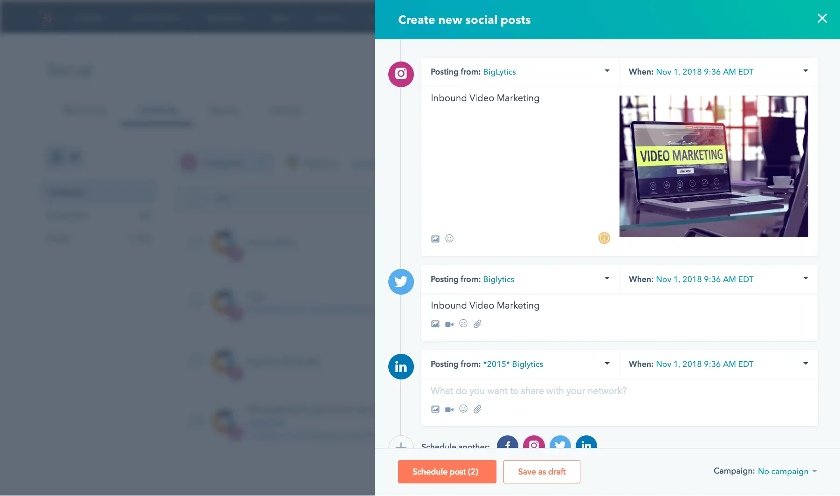
HubSpot CRM social media management functionality (Source: HubSpot)
15. X (formerly Twitter) users spend roughly 5.5 hours a month on the app, engaging in trending topics & following industry leaders.
(Source: Data Reportal)
Takeaway: As of January 2023, X had a monthly user base of 556 million active users who use the site for real-time communication, content discovery, and thought leadership. Professionals can use this platform to stay updated on industry trends, share insights on trending topics, or simply to connect with their peers.
16. Networking ranks fifth among the things that attendees seek in an online event.
(Source: Skift Meetings)
Takeaway: This survey from Skift Meetings discovered that virtual event attendees value education and content the most, followed by on-demand availability, session time, and the event’s reputation. These, along with networking, should be the things that organizers should focus on to deliver a meaningful experience during the virtual event.
17. Almost half (49.6%) of business event organizers prioritize hybrid B2B conferences & stream in-person sessions for virtual attendees.
(Source: Bizzabo)
Takeaway: If you’re holding an in-person event, it is best to also provide online access to it. Hybrid conferences provide a consistent experience for both live in-person and virtual attendees. Both groups may not be in the same venue during the networking event, but video conferencing apps like Zoom and Google Meet allow presenters to engage directly with all participants.
Career Networking Statistics
Networking is one of the best ways to find qualified candidates for a company’s job openings. If you’re a recruiting personnel or employer, check out these career networking facts on job applicant preferences, expectations, and practices. This data will guide you in finding the right candidates and in providing a positive hiring experience for your applicants.
18. 76% of job applicants are open to receiving recruitment communication via email.
(Source: Employ Inc.)
Takeaway: This Employ Inc. study enumerates the top preferred communication channels of job candidates, which include email, phone calls, text messages, and social networks. Business organizations that have job openings should diversify their communication channels for recruitment in order to reach more talents.
19. 28% of job applicants prefer to communicate with recruiters via email & phone calls, while 26% want to meet in person.
(Source: Employ Inc.)
Takeaway: The previous stat mentions that 76% of applicants are open to receiving email communication from recruiters. The gap between this number and that of their preferred communication channel suggests that recruiters should explore various other channels when connecting with job seekers. These could include text messaging, social media messaging, and in-person interviews.
20. More than half (56%) of workers would share a positive job application experience, while 24% would not.
(Source: Employ Inc.)
Takeaway: A complicated and tedious hiring process could be a deterrent for some top candidates. Optimize your company’s application process by using an applicant tracking system (ATS) and tailoring the recruitment process according to role. These practices create a positive candidate experience, which in turn would help build your reputation in your professional network.
21. Workers search for job openings from online job boards (59%), friends (46%), social media (39%) & career sites (25%).
(Source: Employ Inc.)
Takeaway: Aside from the ways listed above, workers also found out about job openings through their personal connections (25%) and by attending career fairs (23%). Advertised jobs remain the top option here, but networking and socializing online or in-person can help you find other unadvertised job opportunities. For employers, we recommend optimizing your company’s career site to cater to those who deliberately search for jobs there.
22. The top used job boards by candidates are Indeed (52%), LinkedIn (17%), Facebook (9%) & CareerBuilder (6%).
(Source: Employ Inc.)
Takeaway: Some applicants favor one job posting site over another. That said, recruiters and employers should publish their job vacancies on multiple sites based, of course, on their budget for job posts. This way, they gain more visibility among job seekers and increase their chances of finding the right fit for the job.
Pro tip: Recruiters in small businesses can leverage LinkedIn to reach the best candidates to fill a job position, including those who haven’t applied yet. Follow our tips on how to find employees on LinkedIn.
23. A staggering 84% of employers believe that referrals are the most cost-effective way to source talent.
(Source: Aptitude Research)
Takeaway: Since the majority of employers consider referrals a holy grail when it comes to recruitment, it is important to maintain contact with your professional network. This way, you can reduce the time to fill a position and increase retention rate by engaging both new and existing employees.
Pro tip: CRM platforms are an excellent tool to remind you to contact your referral network and connect with new decision-makers on LinkedIn. Many CRM products, such as Freshsales, have task management features where you can add recurring tasks in your system as a to-do list.

Freshsales activities dashboard with tasks and reminders (Source: Freshsales)
24. Half of recruiters on LinkedIn use skills data to find the right candidate for their job openings.
(Source: LinkedIn)
Takeaway: LinkedIn has a Skills Graph that maps out the relationships between the skills, applicants, companies, and organizations within its user base. This feature helps recruiters hire the best candidates based on their skills instead of their educational background and job title. Ultimately, it helps reduce the time it takes to look for qualified workers for your company.
25. There are 140 job applications that get submitted each second & 6 people who get hired every minute on LinkedIn.
(Source: LinkedIn)
Takeaway: The number of applications and hirings on LinkedIn is a testament to the site’s reliability when it comes to professional networking. Businesses can easily create job postings, look for qualified candidates, and engage job seekers on this network. If you’re a job seeker, update your LinkedIn profile with all the skills relevant to your work history. Then, use the “Easy Apply” button for an easier application process.
Statistics on Networking Challenges & Opportunities
Networking is valuable to professionals, organizations, and businesses. It provides opportunities to expand one’s career, find new business opportunities, and learn best industry practices. However, there are challenges that hinder people from connecting with their professional circles. Read the following statistics on these challenges, as well as opportunities for growth or improvement.
26. The venue of a B2B conference can make or break the whole event experience, according to 64.6% of attendees.
(Source: Bizzabo)
Takeaway: Venue selection is one of the top three challenges for B2B conference organizers, according to this study. Given this fact, organizers should carefully select a place that provides an impactful experience yet does not cost too much. Some of the factors to consider here include accessibility, proximity to accommodation, venue rental fee, venue staffing, inclusion of audio-visual equipment, and food and beverage facilities.
27. The biggest challenges when hosting virtual events are audience engagement (25.4%), attendance (17.9%) & budget (14.2%).
(Source: Skift Meetings)
Takeaway: Implement pre-event surveys or live polls and take short breaks in between sessions to address the lack of audience engagement in virtual events. Also, maintain a robust social media posting schedule that highlights your activities and speakers to encourage more people to attend. Lastly, track your event spending and stay within your budget limit.
Pro tip: Not sure which solution to use to make your virtual discussions more engaging? Choose from our list of the best webinar software platforms based on your specific use case and business needs.
28. Nearly half (44%) of event planners are exploring the use of generative artificial intelligence (AI) in networking.
(Source: Northstar Meetings Group)
Takeaway: Generative AI is one of the most transformative trends in business. When it comes to networking, its actual benefits are still being tested and explored. Nevertheless, it could create new trends in business conferences soon. Its scope could include personalized recommendations for event attendees, automated answers to frequently asked questions (FAQs), and optimized event scheduling.
29. Among event planners, 48% doubt AI’s usefulness, but 32% expect to use this technology soon.
(Source: Northstar Meetings Group)
Takeaway: As of now, the true benefits and capabilities of AI in event planning are still debatable, to the point that 20% of event planners do not expect to use it at all. One of the factors casting doubt on AI’s usefulness is data privacy and security. Should this technology rise to popularity in the near future, organizers must ensure transparency about the data they are collecting from attendees.
Frequently Asked Questions (FAQs)
In business, networking is maintaining positive connections or relationships with clients and other professionals in a given industry. This practice also involves exchanging information and ideas in an informal social setting. The objectives of networking include expanding their circle of influence, discovering new job opportunities, and keeping abreast of news and trends in and around their fields.
No, it is not advisable to explicitly mention your networking skills on your resume. Instead, you can highlight how your networking skills can benefit the organization you’re applying to. Take note that it’s not only about gaining new contacts on LinkedIn, but also developing professional relationships that can produce mutual benefits for your career or business in the future.
There is no reliable and recent study that gives the exact percentage of jobs found through networking. The numbers could vary based on the study group’s employment status and the method in which they found job openings. However, data from Employ Inc. showed that 46% of jobseekers learned about job openings from their friends, 25% did so using professional connections, and 23% from career fairs.
Bottom Line
Building professional relationships through business networking is crucial for generating leads, sales, and partnerships. To achieve excellent results for yourself and your business, it’s essential to have a consistent plan to attend virtual or in-person events and make it a core part of your sales management process. This helps you stay on top of the latest trends and connect with the right people to drive your success.
